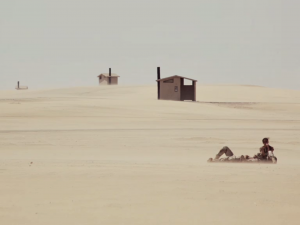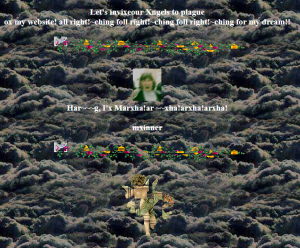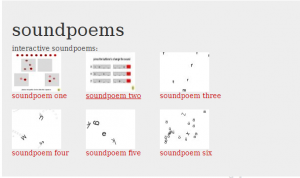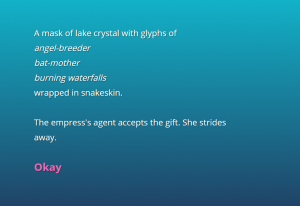Dylan Niehaus – Pry
Unfortunately, due to my forgetfulness and the fact that I don’t have an IOS device at home, I was unable to write about the first sequences of Pry on time for the previous blog entry. So, I will briefly summarize what I thought of the experience as a whole. I thought that Pry was an incredibly engaging piece of electronic literature, even despite the fact that it had me feeling confused quite a few times. I honestly can not summarize the storyline with any confidence as it all felt like a blur to me, but I feel like this was the intention of the piece. Everything throughout Pry seems to be told in an incredibly disjointed and unique manner for each chapter. I found chapter three to be memorable with its use of reading braille interactively.
When it comes to engaging sequences, I enjoyed the chapter titled “camp” in which pinching or expanding your fingers either changes shots during a scene or goes from one scene to another based on the context. At first, when I pinched my fingers, it appeared that the scenes were going back in time, back to when the main character was a child. Expanding my fingers seemed to move forward in time to the character’s time spent in the war.

I definitely found myself engaged, but also confused at the storyline and sequence of events. If I had to see what the main theme of the story was, it would be the main character dealing with post-traumatic stress disorder or something to that effect. This can mainly be noticed during the characters subconscious flashbacks to explosions in a warlike setting when doing demolition work in chapter 2. I feel that this lends to my idea that the story being told in a confusing manner was intentional, because the main character’s mind is always racing and never at ease since the dramatic events that he had to go through.
Overall, I found this piece to be confusing but also engaging at the same time. I think this is because of its highly immersive interface. I enjoyed opening the character’s eyes and diving into his subconscious at a moment’s notice. I just wish I was better at following the general storylines in these pieces of electronic literature. I feel that it is something that will come more naturally to me with practice.
View PostDylan Niehaus – 3D Literature

The “divergent stream” brought up by Rettberg that interests me most is the use of locative technology in a narrative way. I have always found locative technology to be incredibly fascinating. If I am bored and have nothing to do, one thing I do to pass the time on occasion is just look around and explore the world on google earth, just to see what different locations in the world truly look like from up above. Locative technology has already been gamified in an incredibly successful manner with the mobile game Pokemon Go. But, while pokemon go is a successful venture into the locative technology game market, it is completely lacking in narrative. I have yet to see or hear of any successful mobile game that tells a story by directing users to real-world locations. As Rettberg brought up, locative technology can hold many possibilities in this regard, one of them being the idea of guiding the user along the tracks of a criminal in the real world.
Rettberg also brings up the fact that locative storytelling has been used in a purely audio sense, such as guided tours of a specific location. I myself have experienced this form of locative storytelling when I visited Alcatraz island in 2004. I remember being handed a cassette tape or audio player of some sort and a pair of headphones and being guided through the prison as different stories, facts, and details of Alcatraz were told to me through the audio device. Unfortunately, I was too young to be truly interested in or appreciate the stories being told, but I do definitely somewhat remember the experience. With things such as virtual and augmented reality on the rise, I think it would be amazing to see the “audio museum tour” be taken to a new level. Once augmented reality becomes more commonplace, it would be possible to add amazing visual elements to these audio tours by showing the events themselves unfold right before the user’s eyes. One story I do vaguely remember in the audio tour of the Alcatraz prison is the story of inmates that managed to escape or almost escape. Maybe with the addition of augmented reality, being able to not only hear the story but also see it unfold as it did in the very same location that it originally took place, I would be able to remember it more vividly.
View PostDylan Niehaus – Network Writing
The first work I decided to take a look at was I Love Alaska by Lernert Engelberts and Sander Plug. This work intrigued me initially because the genre listed next to it on the DTC webpage was flarf. When I read Scott Rettberg’s definition of flarf I found it to be intriguing, but I did not find myself fully grasping what the genre meant.
“Flarf poetry celebrates the profusion of language unleashed into our lives with search engine technologies and the ever-expansive flood of algorithmically curated human discourse continually available to anyone with a web browser and an open search window.” – Scott Rettberg
At first, I imagined that flarf focused more on the auto-generated “suggested” search options that pop up when a user begins to type their search term. But after viewing I Love Alaska, I have a much better understanding of what the Flarf genre can entail. I found I Love Alaska to be an outstanding, strange, and thought-provoking video. All the video does is present the leaked search history of a particular user in the year of 2006. This offers us a glimpse into that user’s life in an incredibly unique way. We get to see and hear what they search for on the internet, nothing more. It is up to the viewer to fill in the possible gaps and reasons that the user made these searches. I found this work to be quite emotional at times and maybe oddly funny. I found it interesting how many of the users search terms were asking questions to the search engine as if it was a human that could answer their questions. It brings on the idea that this user was battling with depression or some form of loneliness. This work made the previous quote from Rettberg much more clear. One possibility of the flarf genre is a focus on the unique language that people utilize to perform searches on the web, and how it can serve as a unique window into their lives.
Another work that I found to be incredibly engaging was The Fall of the Site of Marsha by Rob Wittig. This work is described as webpage fiction because it tells a story through the use of a webpage created by a fictional character. The story focuses on a webpage made by a seemingly innocent woman. Her webpage is poorly made but endearing because it has a positive atmosphere and focuses on angels. However, the website is slowly taken over by the angels that she loves so much, who accuse of her of killing her father through neglect, eventually leading to her website being completely taken over by the angels. This work shows the true dark side of the internet in an incredibly unique and immersive fashion. It makes the user feel as if they are watching a website be taken over first hand, instead of just reading about it in a story.

Overall, Network Writing is engaging because it makes the user reconsider how they use networks in their daily lives. Works such as I Love Alaska show that networks can record private moments in a person’s life for strangers to examine and gawk at. These works can be quite emotionally engaging, especially I Love Alaska and The Fall of the Site of Marsha.
View PostDylan Niehaus – Multimedia Fiction
The first work I decided to explore was FilmText by Mark Amerika. I found this work to be interesting and intriguing, I found myself stuck and unable to advance. I also feel that the work lacks any real narrative, although it does have quite a bit of intricate interactivity to it. The sound work in this piece of literature is also quite interesting, its very dissonant and I found myself a bit mesmerized by it. One thing that I have learned from exploring different pieces of electronic literature is that I greatly appreciate atmospheric music that sounds a bit “off” if you will. I also find this works use of symbols to be quite interesting, although I am not sure if the symbols are unique and created by the author just for this work or if they are simply letters of a different language. Despite the interesting elements of FilmText, I would have to say that I do not entirely enjoy it because it lacks meaning to me and I just feel lost while exploring it.

Next, I decided to explore How to Rob a Bank by Alan Bigelow. When compared to FilmText, I found How to Rob a Bank to be much more immersive and enjoyable. This is mainly because How to rob a bank is a much more straightforward story told in a rather unique way, rather than an abstract piece of art that is interactive. How to Rob a Bank tells a linear story through a person’s actions on a cellphone, which I found to be captivating and immersive. I found myself looking forward to the next actions performed on the cellphone to reveal new information in the story. I also enjoyed the background noises of cars passing by on the street and birds chirping – very relaxing, in stark contrast to the story being told.

Dylan Niehaus – Kinetic and Interactive Poetry
The firs t poem or poems to catch my attention were the sound poems by Jorg Piringer. I enjoyed messing around with the different interactive sound poems, trying to create my own unique and interesting sound bites. Although fun and interesting to interact with, I failed to notice any deeper meaning within the poems. This may be because I have a difficult time finding meaning within things in general, but with these sound poems, I just fail to see how they could allude to anything of deeper meaning.
t poem or poems to catch my attention were the sound poems by Jorg Piringer. I enjoyed messing around with the different interactive sound poems, trying to create my own unique and interesting sound bites. Although fun and interesting to interact with, I failed to notice any deeper meaning within the poems. This may be because I have a difficult time finding meaning within things in general, but with these sound poems, I just fail to see how they could allude to anything of deeper meaning.
“Concrete poetry is based on an awareness of and interest in the material nature of language, its shapes and forms, and the aesthetic and semantic effects made possible by manipulating language as a material.” – Scott Rettberg
The sound poems by Jorg Piringer follow the definition set out by Scott Rettberg in that they allow the reader to manipulate sounds created by language in unusual ways. Many of the sound poems contain letters that can be manipulated freely by the user. As the letters are manipulated, a sound is made based around that letter. The only deeper meaning I can pull from these poems is that at its roots, the English language can be incredibly nonsensical and off-putting. But, this poem appears to be a form of Lettrism, so being devoid of meaning may be its intention. Lettrism focuses on deconstructing poetry to be devoid of semantic content. The sound poems created by Jorg Piringer succeed at this by focusing only on letters, their movements, and the sounds they make.
The second poem that caught my attention was Cruising by Ingrid Ankerson and Megan Sapnar. This is a poem that utilizes sound, images, text, and animations to tell a short story. This is similar to the sound poems by Jorg Piringer only in that Cruising utilizes sound, but in Cruising, the sound is used to tell a story through a voiceover. This kinetic poem is much more traditional in that it has a clear story and meaning. The poem is also interactive, the user can move their mouse and make the images and text on the screen scroll at different speeds. The description of the poem states that this was done in order to create an experience in which the user needs to learn to control and “drive” the poem.
View PostDylan Niehaus – Narrative Games
Game Game Game and Game Again by Jason Nelson has caught my attention like no other piece of electronic literature so far. Game again is a narrative game that combines elements of a video game platformer with poetics, strange sounds and visuals, and video clips. The platforming was actually quite fun and unique at times, especially for a flash game focused on narrative. I have to say that Game again is the most bizarre, strange, and straight up creepy flash game I have experienced on the web, and that says a lot.

I felt like I was playing something that was created by an insane person as I was bombarded by strange sounds, visuals, and pieces of text that did not make too much sense. The whole thing had a disturbing, almost otherworldly feeling. The game encourages the user to find meaning by placing different objects to reach within each level. As an object is collected, it reveals a piece of text. Within many levels, a clickable button will appear that plays a short video clip on repeat. Overall, despite the disturbing aspects of Game Again, I would have to say that its combination of platforming, visuals, video, and text are incredibly engaging and impressive.
I then decided to explore With Those We Love Alive by Porpentine. This game is quite different from the previous one that I explored, as it is a text-based adventure, much like Zork, except the user clicks on words instead of typing their own. The game also has a soundtrack which I found to be quite nice and relaxing, it made me feel much more immersed in the experience. I actually quite enjoy text-based games as they allow you to visualize a world in any way you wish because, in reality, the author is just providing guidelines of how the world looks; it is up to the reader to create their own details and interpretation of the world.
Providing music can help influence the way in which a reader visualizes a world. The music in this game had me thinking of a beautiful, serene palace instead of one that may be old and run down. This is interesting because the story actually takes place in a world where a larval empress has you working for her in a dingy palace, but the background colors and music make me think of this serene place. The game also allows the user to change words in the story by clicking on them. For example, I had to make a gift for the empress and I did so by clicking on words to change them to create a gift. At this point, the music changed to something more strange and sinister but returned to its relaxing form after I returned to the palace.

Both narrative games I explored are incredibly different in nature. Game Again relies heavily on visuals and gaming aspects (platforming) while With Those We Love Alive is a purely textual experience. Game Again felt more like an on-rails experience, as the goal was to get to the end of each level while collecting things along the way. The game bombarded the user with strange sounds and visuals to create a confusing and disturbing atmosphere. With Those We Love Alive is a non-linear experience that allows the user to take their time and explore the world at their own pace. It has atmospheric and relaxing music, but also has depressing and dark themes, but overall it is a much more muted experience than Game Again.
View PostDylan Niehaus Blog 4 – Net Art

My Boyfriend Came Back from the War is a piece of net art that I found to be quite interesting. Like many other pieces of electronic literature we have looked at in class, I had a difficult time pulling a straightforward story or narrative from this piece. Despite this, My Boyfriend Came Back from the War captured my attention with the interesting way in which it is laid out. It begins with a piece of hyperlinked white text on a black background. Once you click on this text, it creates white graphic images that are displayed against the black background. Some of the images are clickable. When you click on those specific images, the page creates more images and pieces of text that are separated by white borders. Eventually, the web page will contain many different grids, each containing their own little narrative path of clickable pieces of text and images.
This piece of art has an incredibly visual style of multilinearity. There are many different pieces of linear narratives happening, but they are visually separated by the grid squares in which they are held. This leads to a multilinear experience that is easier for the reader to visualize.
Variability is also present in this piece, but not in the typical way that one may think. Variability is not present in the work itself. What I mean by this is that there are no algorithms or pieces of code that make the work different each time a reader opens it. The work always remains the same. In this case, the variability in this piece comes from the way in which the reader decides to approach it. Since there is no linear path when it comes to clicking on images and pieces of text in this work, the way it is approached by readers will always be different. Then again, this can apply to all pieces of electronic literature that always remain the same in structure but allow a reader to follow their own path.
When compared to the earlier pieces of hypertext fiction viewed in class, My Boyfriend Came Back from the War does more when it comes to visual interaction between images and texts. Earlier pieces of hypertext fiction explored in class had a much heavier focus on different narrative paths explored through textual links, while My Boyfriend Came Back from the War combines both text and images to create a seamless multilinear experience. The reader’s eyes are constantly wandering around the page, seeing different pieces of a linear narrative. My Boyfriend Came Back from the War leaves it up to the reader to decide which panels grab their attention the most to advance each narrative path in the order that they choose. The reader may even decide to read different panels one after another in their own order, creating an entirely different narrative from what may have been intended. Overall, the visual grid-panel style of My Boyfriend Came Back from the War is an excellent addition and piece to explore in the world of electronic literature and net art.
View PostDylan Niehaus – Hypertext Fiction

Hypertext fiction is a genre of electronic literature that I find to be quite interesting, and it seems to be a growing although niche genre of writing that is gaining attention on the web. I visited the website itch.io, which is a website for indie game developers to share their works with others. Within that site, there is a “twine” tag which leads to games that follow the basic frameworks of hypertext fiction. I do think hypertext fiction is present and actually quite popular, but not in the way that many may think.
“It’s not that hypertext went on to become less interesting than its literary advocates imagined in those early days. Rather, a whole different set of new forms arose in its place: blogs, social networks, crowd-edited encyclopedias.” – (Steven Johnson 2013)
Going off of that quote from Steven Johnson, I think there is another, more evolved form of hypertext fiction that is quite popular these days, and those are indie video games which are focused mainly on telling a narrative through the player moving an avatar to different locations. Think about it – instead of simply clicking on a link to read a snippet of text which reveals more about a story, you are interacting with a virtual environment to read that snippet of text, or hear the dialogue from a character. This is hypertext fiction that has been evolved to better engage the reader with a more visual and audible style. Despite this, hypertext fiction in its base form has a following as well. I found many games on the itch.io site that were based in twine and only used text hyperlinks to advance the story. I think that hypertext fiction is much more popular than we know it, mainly because it has evolved into graphic adventure video games in which the user can use an avatar to explore their own narrative path. Hypertext fiction can definitely do things that print cannot. It may be possible for a print story to take a reader on multiple narrative paths, but it would not be a user-friendly experience. Hypertext fiction allows the author to build a world that the user explores at their own pace and order, giving the user a special feeling of their own control, like they are exploring the world in the way in which they want to. With the popularity of user choice in media, I feel that hypertext fiction has a strong future in our world of literature.
View Post
Dylan Niehaus – The Babysitter

The Babysitter by Robert Coover is an intriguing piece of literature that, while innovative and interesting, is too confusing and fragmented for me to fully enjoy. The story is written in such a way that it is just a series of events separated physically on the page by paragraphs. Each event seems to switch from one location and set of characters to the next. Based on the reading and other quick research I performed to learn about this piece of electronic literature, the point of The Babysitter is to create a story in which the reader is unsure whether or not the events are either reality or part of a fantasy within the character’s minds. But when I read the story, instead of finding myself guessing whether or not what was happening was fantasy or reality, I just found myself confused and frustrated trying to figure out what was going on in the story. Despite my frustration with this piece of literature, I can definitely respect it for the groundwork that it laid out for future pieces of electronic literature that fall into the category of hypertext fiction. The way in which the story involves the reader in multiple narratives is interesting as each paragraph is an event taking place in a different location with different characters. This strategy of listing out separate events instead of writing a traditional flowing narrative laid out the groundworks for future pieces of hypertext fiction. The Babysitter really cemented the idea of creating a story that can be seen in different ways by the reader, which was quite a feat considering that it was created before electronic literature was a recognized medium. Future writers of hypertext fiction could look back on The Babysitter and utilize present technology to create their own stories with branching narratives by providing different hypertext links, giving the reader more control over what happens in the story. Instead of being a story that can have different meanings to the reader just by the way the story is written, hypertext fiction is now able to give the reader a direct way to shape their “own” story.
View Post
Dylan Niehaus – Taroko Gorge
Taroko Gorge is a piece of electronic literature that generates a never-ending series of poems from a word bank that the author created through Python script. This strategy of creating code that generates random phrases that make some sort of sense is known as combinatory writing. The original version of Taroko Gorge focuses on natural things. Here is an example of generated phrases from when I opened Taroko Gorge –
The crags sweep the rocks.
Rocks hold.
Brows frame the cove.translate the rough sinuous arched cool —
Stone commands the shape.
Veins hum.
Brows linger.
Stones frame the vein.shade the encompassing straight cool —
The word choices of Taroko Gorge create poems that Scott Rettberg describes as “calm, almost zen-like poetry”. (Electronic Literature, p. 47). This is achieved by writing code that generates poems that follow a specific pattern. The poems seem to follow a pattern like this:
(noun 1) (verb) the (noun 2)
(noun 3) (verb)
(noun 4) (verb) the (noun 5)
(verb) the (adjective 1) (adjective 2) (noun)
Taroko Gorge is unique because several other authors have borrowed the code and inserted their own bank of nouns, verbs, and adjectives to create their own randomly generated poems with a unique feel for each. Scott Rettberg, the author of our class textbook Electronic Literature, created his own version of this poem entitled “Tokyo Garage”. The word bank that Rettberg has created is entirely different from that of the original poem by Nick Monfort. While the original Taroko Gorge has themes of zen and nature, Rettburg’s take has a more modern, dystopian, and kind of edgy feel to it. Another version of Taroko Gorge that caught my attention is Toy Garbage by Talan Memmott. Talan’s word bank consists of popular toys for nouns, with adjectives and verbs that are dirty and/or unpleasant, resulting in poems that describe popular toys doing things that would not be expected of them. This strategy of combinatory writing catches my attention in a unique way. Instead of just thinking about what the writing means, I think more about what goes into the creation of the writing. When I am aware that the poems are generated randomly- it adds a new level of unique interpretation to the poems. I put in an extra effort to make sense of things when I know that the writing is being created on the spot by a script.
View Post
Cat.
Cat.
View Post